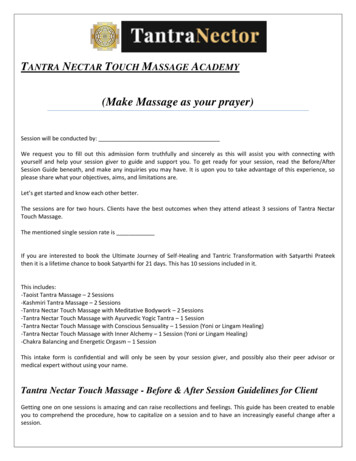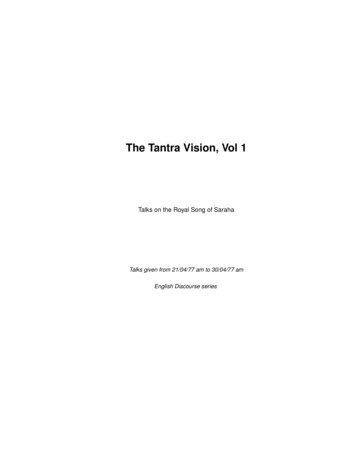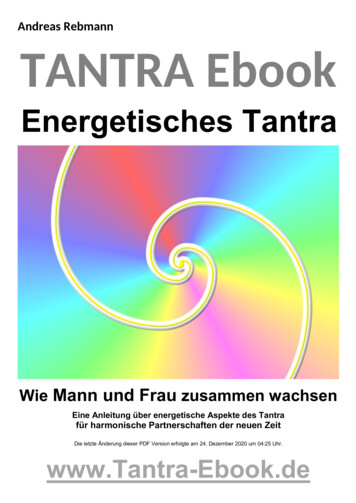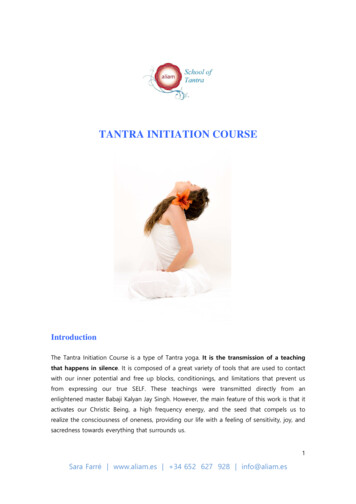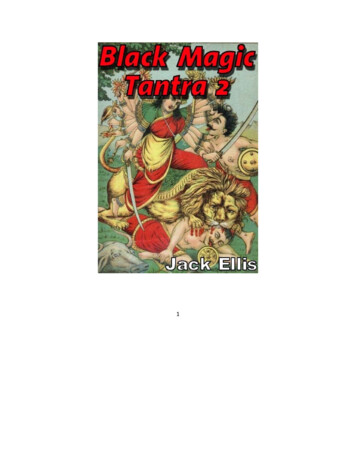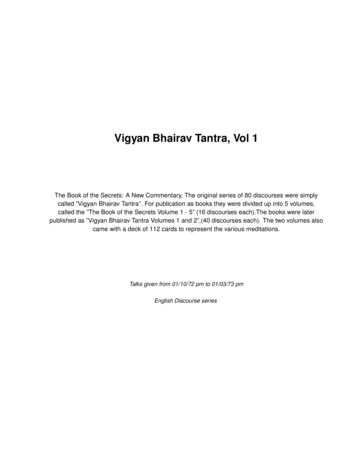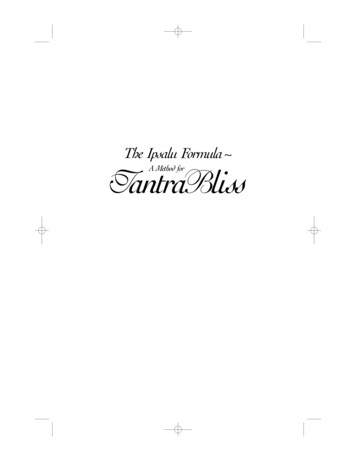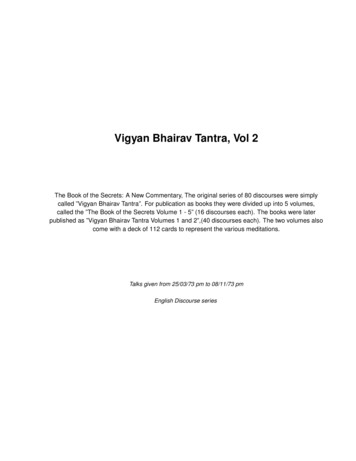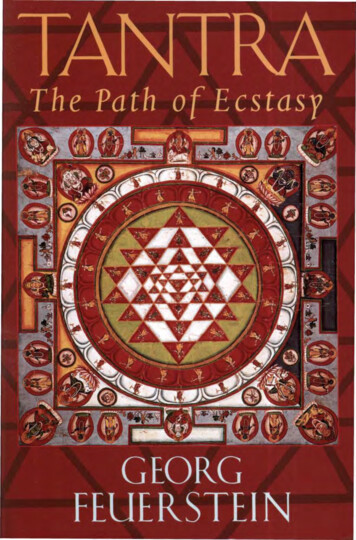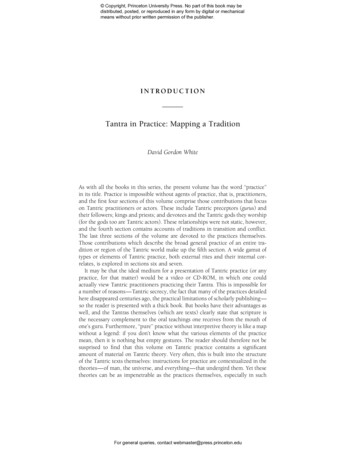
Transcription
Copyright, Princeton University Press. No part of this book may bedistributed, posted, or reproduced in any form by digital or mechanicalmeans without prior written permission of the publisher.INTRODUCTIONTantra in Practice: Mapping a TraditionDavid Gordon WhiteAs with all the books in this series, the present volume has the word ‘‘practice’’in its title. Practice is impossible without agents of practice, that is, practitioners,and the first four sections of this volume comprise those contributions that focuson Tantric practitioners or actors. These include Tantric preceptors (gurus) andtheir followers; kings and priests; and devotees and the Tantric gods they worship(for the gods too are Tantric actors). These relationships were not static, however,and the fourth section contains accounts of traditions in transition and conflict.The last three sections of the volume are devoted to the practices themselves.Those contributions which describe the broad general practice of an entire tradition or region of the Tantric world make up the fifth section. A wide gamut oftypes or elements of Tantric practice, both external rites and their internal correlates, is explored in sections six and seven.It may be that the ideal medium for a presentation of Tantric practice (or anypractice, for that matter) would be a video or CD-ROM, in which one couldactually view Tantric practitioners practicing their Tantra. This is impossible fora number of reasons—Tantric secrecy, the fact that many of the practices detailedhere disappeared centuries ago, the practical limitations of scholarly publishing—so the reader is presented with a thick book. But books have their advantages aswell, and the Tantras themselves (which are texts) clearly state that scripture isthe necessary complement to the oral teachings one receives from the mouth ofone’s guru. Furthermore, ‘‘pure’’ practice without interpretive theory is like a mapwithout a legend: if you don’t know what the various elements of the practicemean, then it is nothing but empty gestures. The reader should therefore not besusprised to find that this volume on Tantric practice contains a significantamount of material on Tantric theory. Very often, this is built into the structureof the Tantric texts themselves: instructions for practice are contextualized in thetheories—of man, the universe, and everything—that undergird them. Yet thesetheories can be as impenetrable as the practices themselves, especially in suchFor general queries, contact webmaster@press.princeton.edu
Copyright, Princeton University Press. No part of this book may bedistributed, posted, or reproduced in any form by digital or mechanicalmeans without prior written permission of the publisher.4DAVID GORDON WHITEesoteric traditions as these. Therefore, a second level of interpretation is in order,and this is the invaluable contribution of the thirty-nine scholars whose chaptersare presented here, for not only have they translated the many languages of theTantras into English but they have also translated the multifaceted Tantric worldview into comprehensible language in their introductory essays.I have attempted to do the same in this general introduction, and the readerwill find that my analysis is based in no small part on the work of these samescholars, whose publications I cite. In this introduction, names in [square brackets] refer to contributions found in this volume; references in (parentheses) referto works found in the bibliography to this essay.Can Tantra Be Mapped?The contributions brought together in this volume all treat of Tantra, a body ofreligious practice that has long defied scholarly attempts at definition. There aremany who maintain that Tantra or ‘‘Tantrism’’ is a Western category, imposedupon Asian traditions in much the same way that the term ‘‘Hinduism’’ was applied, some centuries ago, to a wide swath of mainstream religious beliefs andpractices found on the Indian subcontinent. As Gertrude Stein did for the city ofOakland, such persons assert on the subject of Tantra that there is no ‘‘there’’there. One could make the same claim regarding much of the terminology welive with, of course: the categories of ‘‘religion,’’ ‘‘democracy,’’ and ‘‘art,’’ for example, prove to be quite nebulous when exposed to the glare of critical scrutiny.Others would maintain that the Indian parable of the blind men and the elephantis applicable to Tantra. Depending on which part of the elephant (which specificTantric tradition) a given blind man (scholar) is touching (studying), his accountof the animal (Tantra) will vary widely from that of his fellow blind man. Thescholar examining the fine hard tusk of pure Buddhist esotericism in modernday Japan would find herself hard pressed to recognize that the deeply furrowedhide of the medieval Indian Kāpālika’s (Skull-Bearer’s) practice [Lorenzen] is apart of the same Tantric organism.Then there are the Western dilettantes, the self-proclaimed Tantric entrepreneurs, who have hitched their elephant-wagons to the New Age star to peddle adubious product called Tantric Sex, which they (and their clientele) assume tobe all there ever was to Tantra. It is certainly the case that the earliest accountsof Tantra to reach the West were colonial descriptions from India, penned bymissionaries or administrators who presented its practices as particularly abominable excrescences of South Asian superstition. Their descriptions often includedshocking images of wholesale orgy in which every taboo was broken and allhuman propriety perverted. Over the past two hundred years, there have beenthree sorts of reactions to these distorted images. The first of these is that of Indiaitself: colonial and postcolonial Indians simply deny that such has ever existed;or if it has, that it has had anything to do with Hinduism (another term that defiescategorization). The second is that of Tantric scholar-practitioners, both AsianFor general queries, contact webmaster@press.princeton.edu
Copyright, Princeton University Press. No part of this book may bedistributed, posted, or reproduced in any form by digital or mechanicalmeans without prior written permission of the publisher.INTRODUCTION5and Western, who, in an attempt to rehabilitate this image of Tantra, have emphasized the refined (‘‘right-handed’’) philosophical speculation that grew out ofpreexisting (‘‘left-handed’’) Tantric practices—some of which were of a sexual ortransgressive nature—while generally denying the foundational importance oftransgressivity or sexuality to the traditions themselves. The third, already mentioned, is that of the for-profit purveyors of Tantric Sex, who have no compunctions about appropriating a misguided nineteenth-century polemic to peddle theirshoddy wares.All three interpretive strategies may be viewed as legacies of the original ‘‘text’’of colonial misrepresentations of Tantra in India. All three tend to imagine Tantraas a timeless, unalterable essence or excrescence that did not undergo any changeseither prior to or since its nineteenth-century ‘‘coming out,’’ and that remainedconstant as it was carried outward from India into every part of Asia. As thevariety of contributions to this volume show, neither the sensationalist colonialrepresentations nor the unsatisfactory monothetic responses to them, either ‘‘for’’or ‘‘against,’’ stand up against the empirical data. The picture that emerges is ratherone of a complex array of ritual, theoretical, and narrative strategies that arespecific to their various religious, cultural, sociopolitical, geographical, and historical contexts. Yet for all this, there nonetheless exists a grouping of commondenominators that should permit us to classify these as so many varieties of asingle tradition, the ‘‘there’’ of Tantra.In the pages that follow, I attempt to tease out the parameters and lineamentsof this thing called Tantra from a number of perspectives. The first of these isthematic or phenomenological. This is mainly a comparative endeavor, in whichthe common elements of many types of Tantric theory and practice are juxtaposedand synthesized. This sort of outsider’s assessment of Tantra is an etic one: madefrom a variety of perspectives, it will tend to characterize Tantra in ways notnecessarily recognizable to Tantric practitioners themselves. The Tantric insider’sor emic view must of necessity also be incorporated into our description. Thesetwo perspectives, when juxtaposed with one another, ought to provide us with aTantric ‘‘ideology’’—that is, a set of categorical ‘‘lenses’’ through which Tantricpractitioners have made sense of their practice within their broader worldview(their ontology) and understandings of power in the world (their religious polity),and human salvation in or beyond this world (their soteriology). Systems of practice that are incompatible with or unadaptable to lived experience on the onehand, and to an imagined ontology, polity, and soteriology on the other, will notpersist through time. Perhaps unbeknownst to themselves, practitioners are constantly testing their traditions against lived reality, and although religious changeis notoriously slow, it is nonetheless inexorable. Therefore, if there is still something called Tantra that has persisted since its origins in the middle of the firstmillennium of the common era down to the present day—and I contend thatthere is—its architectonics should be discernable through its emic categories.Our approach, then, will consist of an inductive linking of the most salient featuresof Tantric practice to specific and general Tantric precepts.The second perspective adopted here is historical. It is the case that every SouthFor general queries, contact webmaster@press.princeton.edu
Copyright, Princeton University Press. No part of this book may bedistributed, posted, or reproduced in any form by digital or mechanicalmeans without prior written permission of the publisher.6DAVID GORDON WHITEand East Asian religious tradition has had a Tantric phase or component, andmany of these continue down to the present day. However, none of these havecontinued unchanged since the original Tantric impetus, and it is for this reasonthat our account of Tantra must be historical. No synchronic taxonomy of thesalient features of Tantric theory and practice will suffice; only through a diachronic or evolutionary overview of the various schools, sects, scriptures, bodiesof practice, and lines of transmission that have comprised Tantra will we be ableto make sense of this tradition. Such a historical accounting must not, moreover,be limited to a simple history of ideas. It must engage as well with ground-levelpractice, imagery, institutions, political realities, and the interface between publicand private religion.Third, our approach must attend to the human agents or actors in the dissemination and transformation of Tantric doctrines and practices. Here the followingquestions must be addressed. Which Tantric practitioners have practiced forthemselves, and which have practiced for others as Tantric specialists? What havebeen the social and religious backgrounds of the latter? Who have constitutedtheir clienteles? What have been their clients’ motives for engaging them to perform their functions? When a king or other potentate is a Tantric practitioner,what impact does his patronage have on religious institutions and the religiousand political life of his subjects? What has been the nature of the interface between‘‘popular’’ and ‘‘elite’’ forms of practice? How do theory and practice change whenpractice becomes individual as opposed to collective?Finally, a word about the scope of this endeavor. Because this is a comparativeenterprise (in which different forms of Tantra, from different historical periods,religious traditions, and sociopolitical contexts are being compared), the questionof parameters arises: where does one draw the line between ‘‘Tantra’’ and ‘‘notTantra’’? In other words, if we are attempting to delimit Tantra from other formsof religious practice in Asia, what are our criteria to be for determining Tantra’sspecificity? What is it that has made Tantra stand out from the mainstream (orin some cases, as the mainstream) as a body of practice to live for—and sometimesto fight for, to kill for, or to die for? Throughout the fifteen hundred years of itshistory, Tantra has rarely left people indifferent, and this has been precisely dueto the fact that it has been viewed as something different.Our definition of Tantra must therefore attend to Tantra’s difference, but hereas well we must tread with caution. We may speak in terms of a ‘‘hard core’’ anda ‘‘soft core’’ of Tantra. The former, composed solely of those elements of Tantricdoctrine and practice that are not found anywhere else in the Asian religioustraditions under study, would provide us with a sharply defined but very limitedaccount of Tantra—and one that would, moreover, probably exclude many ofthe doctrines and practices that practitioners have themselves deemed to be Tantric. A more inclusive, ‘‘soft core,’’ definition tends to break down, however, because its parameters will encompass doctrines and practices found in nearly allforms of the various Asian traditions, from the Vedas and early teachings of theBuddha and Mahāvı̄ra down through conventional forms of Hinduism, Jainism,For general queries, contact webmaster@press.princeton.edu
Copyright, Princeton University Press. No part of this book may bedistributed, posted, or reproduced in any form by digital or mechanicalmeans without prior written permission of the publisher.7INTRODUCTIONBuddhism, Daoism, and Shintō, as well as in many nonelite forms of Asian religious practice. For example, much of mainstream Hindu devotional ritual—preliminary purifications, the use of mantras for honoring the deity, forms of worship,and so on—has its origins in the scriptures of the ‘‘soft core’’ of Hindu Tantra,the Śaiva Āgamas. Elsewhere, the Tantric dictum that the human being (as opposed to an animal or a deity) is the creature best suited to salvation or liberationthrough Tantric practice differs little from anthropocentric doctrines of thebroader Hindu, Buddhist, or Jain mainstream. The danger here is that everythingbecomes Tantra, and our category loses its specificity.Yet, at the same time, if we were to deny that this ‘‘soft core’’ is authenticallyTantric, we would fly in the face of the emic understandings of householders andritual specialists from the modern-day Tantric mainstream, including Hindu Śrı̄vidyā practitioners in India and Nepal, Buddhist Gelugpa practitioners in Tibetand the Tibetan diaspora, and practitioners of pure Buddhist esotericism (mikkyō,from the Chinese mijiao, ‘‘esoteric teaching’’) in Japan. If these practitioners consider their daily religious observances as well as their life-cycle rites and postmortem rituals to be Tantric, who are we to say they are wrong?A Working DefinitionTantra has persisted and often thrived throughout Asian history since the middleof the first millennium of the common era. Its practitioners have lived in India,China, Japan, Tibet, Nepal, Bhutan, Pakistan, Sri Lanka, Korea, and Mongolia, aswell as in the ‘‘Greater India’’ of medieval Southeast Asia: Cambodia, Burma, andIndonesia. No form of medieval Hinduism, Buddhism, or Jainism [Dundas] hasbeen without a Tantric component; and some South Asian Islamic traditions have,as well, borne a Tantric stamp [Khan]. In Hindu India, the Pāñcarātra [Flood],Gaud. ı̄ya Vais. n. ava, Sahajiyā, Pāśupata, Kāpālika, Śaiva Siddhānta, Siddha Kaula,Yoginı̄ Kaula, Krama, Trika, Śrı̄vidyā, Paścimāmnāya, Nāth Siddha, Aghori, Bengali Śākta-Vais. n. ava and Bāul traditions, and Tamil Nāyanār and Ālvār traditions[Hudson], have all been Tantric or heavily colored by Tantra.Although Buddhism disappeared from India in the thirteenth century, Indiawas the source of the Buddhist Mahāsiddha tradition [Kapstein] and the cradleof Buddhist Tantra in its Mahāyāna, Mantrayāna, and Vajrayāna (including Kālacakra [Newman]) forms. In Java, the layout of the massive Borobadur monument, begun in the eighth century, is that of a massive cosmogram, perhaps thedharmadhātu-man. d. ala, a Buddhist Tantric rendering of the enlightened universe.The late tenth-century author of the Buddhist Kālacakra Tantra, although he mayhave been born in Java (Newman 1985: 85), probably composed his work, whichcontains a number of references to Islam, in what is now central Pakistan (Orofino1997). Tibetan Buddhism is by definition a Tantric tradition: this applies to thefour major orders (the Nyingmapas, Kagyupas, Sakyapas, and Gelugpas), as wellas to the Dzogchen [Klein] and other syncretistic traditions. Much of the ritualFor general queries, contact webmaster@press.princeton.edu
Copyright, Princeton University Press. No part of this book may bedistributed, posted, or reproduced in any form by digital or mechanicalmeans without prior written permission of the publisher.8DAVID GORDON WHITEof the medieval Chinese state was Tantric, and it was from China that nearly allof the Buddhist Tantric traditions of Japan were transmitted. In China, Tantra hassurvived since the twelfth century C.E. within Daoist ritual practice, and it hasbeen said that Daoism is the most enduring Chinese monument to Tantric Buddhism (Strickmann 1996: 49). Elsewhere, the Chinese Chan (a Sinicization ofSanskrit dhyāna, ‘‘meditation’’) school lives on in Japan as Zen Buddhism [Bodiford]. In Burma, the Zawgyis, Theravāda monk-alchemists, have for centuriescombined elements of Theravāda Buddhism, Daoism, and Tantric alchemy in theirpractice. Cambodian inscriptions indicate the presence of Hindu tāntrikas (practitioners of Tantra) there in the medieval period. Present-day Balinese Hinduismbetrays its medieval Indian Tantric origins, and Sri Lankan cults of the ‘‘demonic’’beings known as yakkhas (yaks. as in Sanskrit) and of Kataragama (the equivalentof Skanda/Mañjuśrı̄) contain elements that may be qualified as Tantric. In Japan,all of the eight schools of Buddhism have a Tantric pedigree, although Shingonand Tendai have been Japan’s most sucessful exponents of ‘‘Pure BuddhistEsotericism.’’Finally, the constitutional monarchies of Nepal and Bhutan are the world’s solesurviving ‘‘Tantric kingdoms’’; their state ceremonial comprises Hindu Tantricliturgies and rituals, and nearly all of their deities are Tantric. One of these,Bhairava, is a Tantric god found in every part of Asia, and worshiped in a Tantricmode by Hindus, Jains, and Buddhists alike. Similarly, the goddesses and godsTārā, Ambikā, Aks. obhya, Mahākāla, Gan. eśa, Avalokiteśvara-Lokeśvara-GuanyinKannon, and Skanda-Mañjuśrı̄, as well as numerous groups of multiple Tantricdeities, are found throughout much of Asia. It is the pan-Asian existence of deitiessuch as these that supports an argument that medieval and precolonial Asianreligions, rather than having been discrete Tantric Hindu, Buddhist, and Jaintraditions, were, to a great extent, Hindu, Buddhist, and Jain varieties of an overarching tradition called ‘‘Tantra.’’On what theoretical basis or bases may we term all of these medieval, precolonial,or modern traditions ‘‘Tantric’’? I will begin by borrowing a definition proposed byMadeleine Biardeau and broadened by André Padoux. Padoux (1986: 273), citingBiardeau, begins by saying that the doctrinal aspect of Tantra is ‘‘an attempt to placekāma, desire, in every sense of the word, in the service of liberation . . . not tosacrifice this world for liberation’s sake, but to reinstate it, in varying ways, withinthe perspective of salvation. This use of kāma and of all aspects of this worldto gain both worldly and supernatural enjoyments (bhukti) and powers (siddhis),and to obtain liberation in this life (jı̄vanmukti), implies a particular attitude on thepart of the Tantric adept toward the cosmos, whereby he feels integrated withinan all-embracing system of micro-macrocosmic correlations.’’This definition concentrates on the goals of Tantric practice (sādhana). Here, Iwish to add a consideration of the nature of Tantric practice itself. Tantric practiceis an effort to gain access to and appropriate the energy or enlightened consciousness of the absolute godhead that courses through the universe, giving its creatures life and the potential for salvation. Humans in particular are empowered toFor general queries, contact webmaster@press.princeton.edu
Copyright, Princeton University Press. No part of this book may bedistributed, posted, or reproduced in any form by digital or mechanicalmeans without prior written permission of the publisher.9INTRODUCTIONrealize this goal through strategies of embodiment—that is, of causing that divineenergy to become concentrated in one or another sort of template, grid, or mesocosm—prior to its internalization in or identification with the individual microcosm. With this, I offer the following working definition of Tantra:Tantra is that Asian body of beliefs and practices which, working from the principlethat the universe we experience is nothing other than the concrete manifestation ofthe divine energy of the godhead that creates and maintains that universe, seeks toritually appropriate and channel that energy, within the human microcosm, in creative and emancipatory ways.This definition, however, must be modified according to its contexts, given thatit would probably be rejected out of hand by many Tantric practitioners, whowould find it at variance with their own particular doctrines and perspectives.Buddhists, for example, would be inclined to replace the term ‘‘energy’’ with‘‘teaching’’ or ‘‘enlightened consciousness,’’ whereas a village-level practitionerwould, if asked, probably feel more comfortable with the term ‘‘beings.’’ However,when this definition is shown to be applicable to major forms of Tantric practiceacross the gamut of its regional and vernacular Hindu, Buddhist, and Jain formsin Asia, it becomes a valuable organizing principle.The Tantric Man. d. alaThe key to understanding Tantric practice is the man. d. ala, the energy grid thatrepresents the constant flow of divine and demonic, human and animal impulsesin the universe, as they interact in both constructive and destructive patterns.Like the Vedic sacrificial altar of which it is a streamlined form, the man. d. ala is amesocosm, mediating between the great and small (the universal macrocosm andthe individual microcosm), as well as between the mundane and the sublime (theprotocosm of the visible world of human experience and the transcendent-yetimmanent metacosm that is its invisible fount). This grid is three dimensional, inthe sense that it locates the supreme deity (god, goddess, celestial buddha, bodhisattva, or enlightened tı̄rthaṅkara), the source of that energy and ground ofthe grid itself, at the center and apex of a hierarchized cosmos. All other beings,including the practitioner, will be situated at lower levels of energy/consciousness/being, radiating downward and outward from the man. d. ala’s elevated centerpoint.Because the deity is both transcendent and immanent, all of the beings locatedat the various energy levels on the grid participate in the outward flow of thegodhead, and are in some way emanations or hypostases of the deity himself (orherself). For Hindu Tantra, this means that the world is real and not an illusion;this is an important distinguishing feature of Hindu Tantric doctrine. Rather thanattempting to see through or transcend the world, the practioner comes to recognize ‘‘that’’ (the world) as ‘‘I’’ (the supreme egoity of the godhead): in otherwords, s/he gains a ‘‘god’s eye view’’ of the universe, and recognizes it to beFor general queries, contact webmaster@press.princeton.edu
Copyright, Princeton University Press. No part of this book may bedistributed, posted, or reproduced in any form by digital or mechanicalmeans without prior written permission of the publisher.10DAVID GORDON WHITEnothing other than herself/himself. For East Asian Buddhist Tantra in particular,this means that the totality of the cosmos is a ‘‘realm of Dharma,’’ sharing anunderlying common principle (the teachings of the buddhas), if not a commonmaterial substance [Rambelli]. More generally, this means that buddhahood isvirtual within all creatures. In the words of the Hevajra Tantra (2.4.70, 75), ‘‘Allbeings are buddhas’’ and ‘‘there is no being that is not enlightened, if it but knowsits own true nature.’’ To render this blissful Buddha nature manifest is the purposeof Tantric practice—whether externalized in rites or internalized in yoga (Kværne1975: 128)—and the body is ‘‘the indispensable organ for contact with the absolute’’ (Faure 1998: 61). Rather than being impediments, the world and thehuman body become channels to salvation.At popular levels of practice throughout Asia, this means that the world ofeveryday life can only be negotiated by transacting with myriad beings extendingfrom the spirit world of the recently deceased to the fierce protector deities thatare the lower emanations or simply the servants of the high gods at the center ofthe elite man. d. alas. Here, embodying the divine is less a goal than a ritual technique (inducing a state of possession) for combatting demons. We will turn tothe nonelite Tantric practice of the man. d. ala in Part Two of this essay; here, weconcentrate on elite theory and practice.The energy levels of the Tantric universe are generally represented as a set ofconcentric circles (cakras) of hypostasized forms of the divine energy which, inaddition to appearing as an array of divine, enlightened, perfected, demonic,human, or animal beings, also manifest themselves on an acoustic level, as garlands or piled-up aggregates of phonemes (mantras); on a graphic level, as thewritten characters of the hieratic alphabets; and as the hierarchized cakras of theyogic body. These same configurations constitute the flow charts of Tantric lineages, with the flow of divine energy (but also the fluid, acoustic, or photic essenceof the godhead; or the teachings of enlightened buddhas) streaming downwardand outward through a succession of male and female deities and demigods—the latter often portrayed in an animal or demonic mode—into ‘‘superhuman’’gurus [Padoux] and their human disciples.In every case, one detects ‘‘fractal’’ patterns, in which the original bipolar dyadof the godhead in essence and manifestation (usually male and female) proliferatesinto increasing orders of multiplicity. Unity in multiplicity is a hallmark of Tantra,and in this respect, it is an extension of earlier, less complex, Asian metaphysicalsystems. There is, in Tantra, an exponential explosion of all preexisting pantheonsof deities, and together with these, an expansion of every sort of category—family,number, color, direction, aspect, and so on—into an intricate cosmic calculus.With its perfect geometric forms and elaborately interwoven lines, the man. d. alais the ideal conceptual tool for plotting the multi-leveled and polyvalent interrelationships between these categories. As such it can, and often does, become selfreferential, a transcendent and ideal ‘‘utopia,’’ entirely abstracted from the ‘‘realworld’’ of which it is the invisible, theoretical ground. Perhaps the best-knownman. d. ala-cum-plotting device in the Tantric universe is the Śrı̄ Cakra or Śrı̄ Yantraof Hindu Tantric practice, a perfectly balanced three-dimensional geometric di-For general queries, contact webmaster@press.princeton.edu
Copyright, Princeton University Press. No part of this book may bedistributed, posted, or reproduced in any form by digital or mechanicalmeans without prior written permission of the publisher.INTRODUCTION11agram comprising of a series of eleven interlocking and embedded triangles (alsocalled cakras) radiating downward and outward from a center point, and enclosedby a circle and a square. The man. d. alas of Buddhist and Jain Tantric practicefollow similar structural and dynamic principles.Even at this level of abstraction, the Tantric man. d. ala remains a templatethrough which humans may interact with the divine, and thereby come to experience reality from a superhuman perspective. The practice of the man. d. alagenerally involves a meditative or performative projection of both the metacosmicgodhead and the protocosmic self into its vortex, followed by an implosion of theentire grid into its center point. Here, the underlying assumption is that thisimplosion is a reversal of the original cosmogony—that is, of a primal impulseor flow (sam. sāra) into manifest existence—back into the source of energiesmapped on the grid. One’s self-projection into the man. d. ala and gradual returnto the center is therefore a return to the source of one’s being; at each level, oneis gnoseologically transformed into a higher, more divine, more enlightened being,until one becomes the god or buddha at the center (except in some dualist formsof Tantra). As we will show, there is an implicit notion of biological successionhere, from the supreme godhead down through a guru-disciple lineage, whichmakes initiation and consecration central features of Tantric theory and practice.Although the name, attributes, and entourage of the deity located at the centerof the man. d. ala vary from one tradition to another, nearly all Tantric practice ofthe man. d. ala has this same goal, of transacting with and eventually identifyingwith that deity. In this practice, movement toward the center, effected through acombination of external ritual and internal meditative practices, entails harmonizing one’s own energy or consciousness level with that of the (deities of the)circle in which one finds oneself. First encountered as obstacles, these divine,demonic, or animal impulses ar
the common elements of many types of Tantric theory and practice arejuxtaposed and synthesized. This sort of outsider's assessment of Tantra is an etic one: made from a variety of perspectives, it will tend to characterize Tantra in ways not necessarily recognizable to Tantric practitioners themselves. The Tantric insider's
